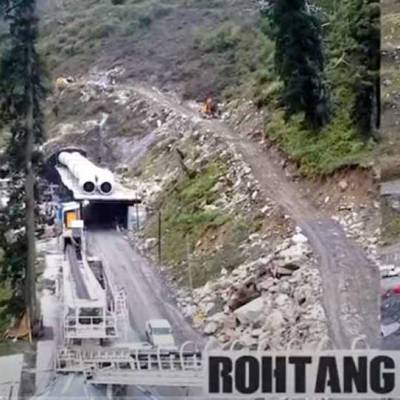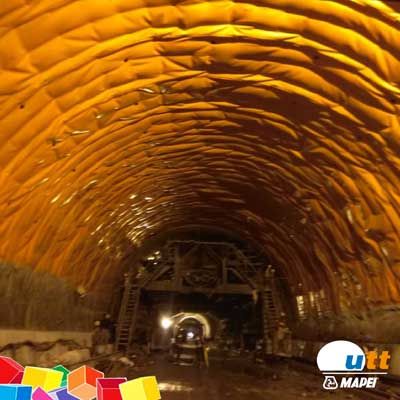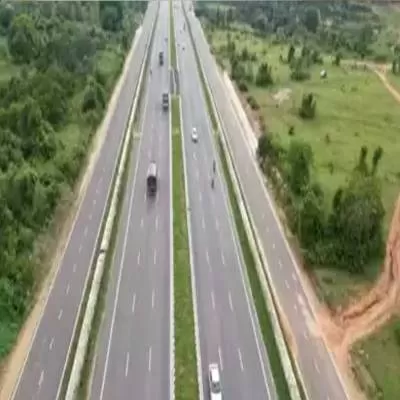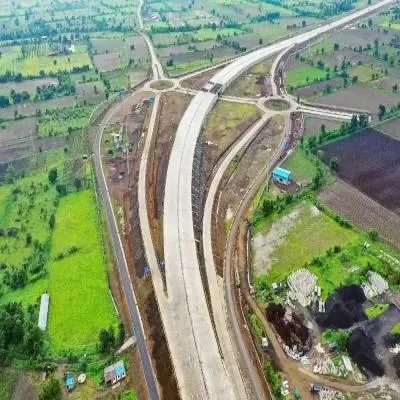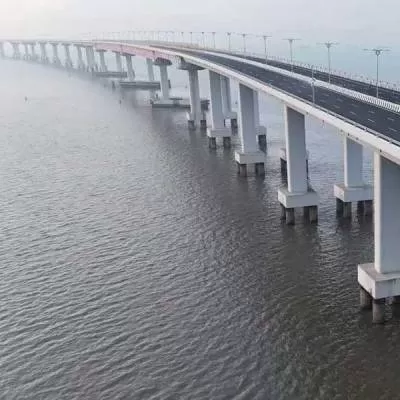- Home
- Infrastructure Transport
- ROADS & HIGHWAYS
- The End of the Tunnel!

The End of the Tunnel!
An idea conceived in 1983 is now taking shape, with the endeavour to be completed and dedicated to the nation by mid-2019. Planning an all-weather route from Manali to Leh has been no easy task.
According to a recent paper published for Tunnelling Asia 2017 under the aegis of the International Tunnelling Association, the Border Roads Organisation (BRO) was tasked in 1987 to carry out the feasibility for the project. In 1990, RITES, which was engaged for the feasibility study, suggested a tunnel along the Manali-Sarchu-Leh route with a tentative length of 8.80 km, starting from Dhundi and connecting Sissu passing under the Rohtang pass as part of the realignment.
With not much progress achieved from 1996 to 2001, RITES submitted the DPR for the construction of the Rohtang Tunnel in 2002. In 2005, based on the DPR, Cabinet Committee on Security (CCS) approval was accorded for construction of an approach road from the North Portal and South Portal, including construction of approach roads, bridges (temporary and permanent), land or property acquisition, and avalanche protection structures, in addition to the approval for tunnel construction work, including design consultancy. Snowy Mountains Engineering Corporation (SMEC) was appointed as design consultant for the tunnel in 2006. And the civil work contract was concluded with STRABAG-AFCON JV (SAJV) in 2009 as per FIDIC norms.
Salient features
The Rohtang Tunnel is being constructed in the Pir Panjal ranges of Himachal Pradesh as the Manali-Sarchu-Leh road remains closed for six months in a year owing to the Rohtang Pass being completely snowbound. It will connect Manali to Lahaul and Spiti Valley throughout the year, and will reduce the road length of Manali-Rohtang Pass-Sarchu-Leh road by 46 km. The South Portal of Rohtang Tunnel is located at a distance of 25 km from Manali at an altitude of 3,060 m, while the North Portal of the tunnel is located near village Teling, Sissu, in Lahaul Valley at an altitude of 3,071 m. The total length of the Rohtang Tunnel is 8.802 km.
The drill-and-blast technique for excavation as part of the New Austrian Tunnelling Method (NATM) is being used for construction.
On completion, this will be the highest road tunnel in the world at an altitude above 3,000 m.
One of the most unique features of the tunnel is the emergency egress/exit tunnel (EET) being part of the main tube itself, thereby adding to the overall cross-sectional area of the opening. This coupled with the young and volatile nature of the Himalayan geology makes the project a formidable challenge for a tunnel engineer.
The design
As per the final design submitted by SMEC, the tunnel alignment consists of seven rock types based on NGI 'Q' system and overburden depths. Each rock type has a unique support system including a combination of shotcrete, rock bolts and lattice girders. Special pre-supports in the form of forepoling and piperoof umbrellas have also been proposed for weaker rock mass.
Some ancillary features of the tunnel include tunnel entry barriers at both portals; telephone connections at 150 m for emergency communication; fire-hydrant mechanisms at 60 m; auto incident detection system with CCTV cameras at 250 m; parking bays at every 1.1 km; turning caverns at 2.2 km; air-quality monitoring at every 1 km; evacuation lighting or exit signs at 25 m; broadcasting system throughout the tunnel; and fire-rated dampeners at every 50 m.
Construction and progress
Being a large project, mobilisation was delayed owing to the requirement of high-value imported machines and the onset of the winter season immediately on conclusion of the contract. Finally, the first blast at the South Portal and the North Portal took place in 2010. The completion of civil works was assigned in 2015. The excavation from South Portal continues through the year but the North Portal is inaccessible for any work between mid-November to mid-May as it is located in Lahaul district, which is accessible only through the Rohtang Pass.
'The 8.8-km, single-tube tunnel is horseshoe-shaped,' shares Parikshit Mehra, Lieutenant-Colonel, Rohtang Tunnel Project. 'Its total width is about 10.5 m, with an excavation diameter of about 13 m. Work started in 2010, and the estimated completion time is the end of 2018; 70 per cent of the work has been completed as far as civil engineering is concerned. We have also crossed 582 m sheer zone, which is the alignment of the tunnel.'
After commencement of the work in the second half of 2010, the work from South Portal continued smoothly till December. As per preliminary studies, the Seri Nala fault was likely to be encountered between chainage 2,200 m to 2,800 m. However, since 2016, the excavation at the South Portal has progressed at a much increased pace. Already in a period of around a year, over 1,600 m of heading excavation progress has been achieved.
Challenges faced
Constructed at an altitude of over 3,000 m, the Rohtang Tunnel is poised to be among the longest highway tunnels in the world. This imposes major challenges owing to extremely low temperatures that need special arrangements for concreting. During the winter months, even the access route to the South Portal needs continuous snow clearance.
The peculiar topographical layout of the mountain range through which the tunnel is being excavated precludes any practical possibility of a shaft or adit. This meant the excavation could be attempted only from the two portals, of which the North Portal is not accessible for more than half the year. This has had major adverse ramifications for the total project duration.
The Rohtang tunnel is a bi-lane tunnel with the escape tunnel built into the tunnel cross-section itself in the form of an EET. The EET is a precast element of 3.6 + 2.2 m + 12 m placed under the carriageway for the complete length of the tunnel and connected to the carriageway through an egress cuddy at every 500 m along the tunnel. This increases the tunnel cross-section significantly, which leads to higher initial deformations. These need to be tackled using an intricate and heavy support system, which solicits extra time and cost.
Specific technologies
As part of its method statement, SAJV used a suspended conveyor system that was planned to be used for mucking from the tunnel face and aid shotcreting in the deep invert sections. However, it could never be used effectively, as the system was not designed keeping in mind the expected poor bearing capacity of strata of the tunnel ceiling, especially in stretches like Seri Nala.
Tunnel seismic prediction is a method based on seismic refraction survey by generating calibrated blast waves. It gives a fair idea of the rock mass ahead of the rock face. This has already been used in the tunnel for a confirmatory survey on eight occasions. However, the system has significant limitations in weak strata as it cannot accurately predict density transitions in softer rock mass owing to limitations of wave propagation.
Learnings in progress
The Rohtang Tunnel is facing severe challenges owing to the way the project has been conceived. The tunnel layout with a uni-directional twin tube would have probably required a simpler support system and one of the tubes could have been used to open more excavation faces for the other tube, especially in the stretches like Seri Nala. The rock classes in the Rohtang Tunnel are based on the NGI 'Q' system, which is an empirical system and does not take into consideration proper geo-mechanical modelling of the rock. The determination of the 'Q' value itself is conjectural and may vary from geologist to geologist. This makes the process of rock class determination difficult and contentious on site. A more robust system based on ground behaviour needs to be adopted.
The contract needs to clearly bring out advance rates for a particular size of excavation, round length and supports used. This would aid the process of estimation of the actual reasonable time required for an encountered rock class stretch. This has overall ramifications for the duration of the project. The FIDIC system in the current form fails to provide any stipulations for advance rates.
The probability of surprises being sprung in tunnels in the Himalayan region is high. It is pertinent that the contractor includes a time-related cost rate as part of the bid so that necessary compensation for any delay because of geological vagaries can be easily arrived at.
In the making
Owing to the geological vagaries, especially the 513-m-long Seri Nala fault zone, the completion of the tunnel has been delayed by almost five years. However, no major geological surprises are now expected and the progress in 2016 has been one of the highest, wherein over 2 km of excavation was achieved in a single year. The tunnel is expected to be broken through within this year and multiple activities like benching, drainage, construction of the EET and the final concrete lining are being undertaken concurrently.
- SHRIYAL SETHUMADHAVAN
(Information compiled from BRO and a recent paper published for Tunnelling Asia 2017)
Know of a landmark project? Write in at feedback@ConstructionWorld.in
With a total length of 8.802 km, the Rohtang tunnel is poised to be among the longest highway tunnels in the world. An idea conceived in 1983 is now taking shape, with the endeavour to be completed and dedicated to the nation by mid-2019. Planning an all-weather route from Manali to Leh has been no easy task. According to a recent paper published for Tunnelling Asia 2017 under the aegis of the International Tunnelling Association, the Border Roads Organisation (BRO) was tasked in 1987 to carry out the feasibility for the project. In 1990, RITES, which was engaged for the feasibility study, suggested a tunnel along the Manali-Sarchu-Leh route with a tentative length of 8.80 km, starting from Dhundi and connecting Sissu passing under the Rohtang pass as part of the realignment. With not much progress achieved from 1996 to 2001, RITES submitted the DPR for the construction of the Rohtang Tunnel in 2002. In 2005, based on the DPR, Cabinet Committee on Security (CCS) approval was accorded for construction of an approach road from the North Portal and South Portal, including construction of approach roads, bridges (temporary and permanent), land or property acquisition, and avalanche protection structures, in addition to the approval for tunnel construction work, including design consultancy. Snowy Mountains Engineering Corporation (SMEC) was appointed as design consultant for the tunnel in 2006. And the civil work contract was concluded with STRABAG-AFCON JV (SAJV) in 2009 as per FIDIC norms. Salient features The Rohtang Tunnel is being constructed in the Pir Panjal ranges of Himachal Pradesh as the Manali-Sarchu-Leh road remains closed for six months in a year owing to the Rohtang Pass being completely snowbound. It will connect Manali to Lahaul and Spiti Valley throughout the year, and will reduce the road length of Manali-Rohtang Pass-Sarchu-Leh road by 46 km. The South Portal of Rohtang Tunnel is located at a distance of 25 km from Manali at an altitude of 3,060 m, while the North Portal of the tunnel is located near village Teling, Sissu, in Lahaul Valley at an altitude of 3,071 m. The total length of the Rohtang Tunnel is 8.802 km. The drill-and-blast technique for excavation as part of the New Austrian Tunnelling Method (NATM) is being used for construction. On completion, this will be the highest road tunnel in the world at an altitude above 3,000 m. One of the most unique features of the tunnel is the emergency egress/exit tunnel (EET) being part of the main tube itself, thereby adding to the overall cross-sectional area of the opening. This coupled with the young and volatile nature of the Himalayan geology makes the project a formidable challenge for a tunnel engineer. The design As per the final design submitted by SMEC, the tunnel alignment consists of seven rock types based on NGI 'Q' system and overburden depths. Each rock type has a unique support system including a combination of shotcrete, rock bolts and lattice girders. Special pre-supports in the form of forepoling and piperoof umbrellas have also been proposed for weaker rock mass. Some ancillary features of the tunnel include tunnel entry barriers at both portals; telephone connections at 150 m for emergency communication; fire-hydrant mechanisms at 60 m; auto incident detection system with CCTV cameras at 250 m; parking bays at every 1.1 km; turning caverns at 2.2 km; air-quality monitoring at every 1 km; evacuation lighting or exit signs at 25 m; broadcasting system throughout the tunnel; and fire-rated dampeners at every 50 m. Construction and progress Being a large project, mobilisation was delayed owing to the requirement of high-value imported machines and the onset of the winter season immediately on conclusion of the contract. Finally, the first blast at the South Portal and the North Portal took place in 2010. The completion of civil works was assigned in 2015. The excavation from South Portal continues through the year but the North Portal is inaccessible for any work between mid-November to mid-May as it is located in Lahaul district, which is accessible only through the Rohtang Pass. 'The 8.8-km, single-tube tunnel is horseshoe-shaped,' shares Parikshit Mehra, Lieutenant-Colonel, Rohtang Tunnel Project. 'Its total width is about 10.5 m, with an excavation diameter of about 13 m. Work started in 2010, and the estimated completion time is the end of 2018; 70 per cent of the work has been completed as far as civil engineering is concerned. We have also crossed 582 m sheer zone, which is the alignment of the tunnel.' After commencement of the work in the second half of 2010, the work from South Portal continued smoothly till December. As per preliminary studies, the Seri Nala fault was likely to be encountered between chainage 2,200 m to 2,800 m. However, since 2016, the excavation at the South Portal has progressed at a much increased pace. Already in a period of around a year, over 1,600 m of heading excavation progress has been achieved. Challenges faced Constructed at an altitude of over 3,000 m, the Rohtang Tunnel is poised to be among the longest highway tunnels in the world. This imposes major challenges owing to extremely low temperatures that need special arrangements for concreting. During the winter months, even the access route to the South Portal needs continuous snow clearance. The peculiar topographical layout of the mountain range through which the tunnel is being excavated precludes any practical possibility of a shaft or adit. This meant the excavation could be attempted only from the two portals, of which the North Portal is not accessible for more than half the year. This has had major adverse ramifications for the total project duration. The Rohtang tunnel is a bi-lane tunnel with the escape tunnel built into the tunnel cross-section itself in the form of an EET. The EET is a precast element of 3.6 + 2.2 m + 12 m placed under the carriageway for the complete length of the tunnel and connected to the carriageway through an egress cuddy at every 500 m along the tunnel. This increases the tunnel cross-section significantly, which leads to higher initial deformations. These need to be tackled using an intricate and heavy support system, which solicits extra time and cost. Specific technologies As part of its method statement, SAJV used a suspended conveyor system that was planned to be used for mucking from the tunnel face and aid shotcreting in the deep invert sections. However, it could never be used effectively, as the system was not designed keeping in mind the expected poor bearing capacity of strata of the tunnel ceiling, especially in stretches like Seri Nala. Tunnel seismic prediction is a method based on seismic refraction survey by generating calibrated blast waves. It gives a fair idea of the rock mass ahead of the rock face. This has already been used in the tunnel for a confirmatory survey on eight occasions. However, the system has significant limitations in weak strata as it cannot accurately predict density transitions in softer rock mass owing to limitations of wave propagation. Learnings in progress The Rohtang Tunnel is facing severe challenges owing to the way the project has been conceived. The tunnel layout with a uni-directional twin tube would have probably required a simpler support system and one of the tubes could have been used to open more excavation faces for the other tube, especially in the stretches like Seri Nala. The rock classes in the Rohtang Tunnel are based on the NGI 'Q' system, which is an empirical system and does not take into consideration proper geo-mechanical modelling of the rock. The determination of the 'Q' value itself is conjectural and may vary from geologist to geologist. This makes the process of rock class determination difficult and contentious on site. A more robust system based on ground behaviour needs to be adopted. The contract needs to clearly bring out advance rates for a particular size of excavation, round length and supports used. This would aid the process of estimation of the actual reasonable time required for an encountered rock class stretch. This has overall ramifications for the duration of the project. The FIDIC system in the current form fails to provide any stipulations for advance rates. The probability of surprises being sprung in tunnels in the Himalayan region is high. It is pertinent that the contractor includes a time-related cost rate as part of the bid so that necessary compensation for any delay because of geological vagaries can be easily arrived at. In the making Owing to the geological vagaries, especially the 513-m-long Seri Nala fault zone, the completion of the tunnel has been delayed by almost five years. However, no major geological surprises are now expected and the progress in 2016 has been one of the highest, wherein over 2 km of excavation was achieved in a single year. The tunnel is expected to be broken through within this year and multiple activities like benching, drainage, construction of the EET and the final concrete lining are being undertaken concurrently. - SHRIYAL SETHUMADHAVAN (Information compiled from BRO and a recent paper published for Tunnelling Asia 2017) Know of a landmark project? Write in at feedback@ConstructionWorld.in


